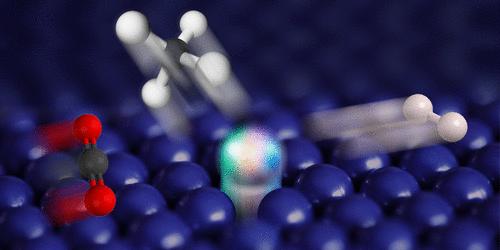On the Tracks to “Smart” Single-Atom Catalysts
IF 15.6
1区 化学
Q1 CHEMISTRY, MULTIDISCIPLINARY
引用次数: 0
Abstract
Despite their enormous impact in modern heterogeneous catalysis, single-atom catalysts (SACs) continue to puzzle the catalysis community, which often struggles to draw correct conclusions in SAC-catalyzed experiments. In many cases, the reasons for such an uncertainty originate from the lack of knowledge of the exact single-atom evolution under operative conditions and the fundamental factors controlling the fate of the single atom in relation to the catalytic mechanism. This has led to confusion also about correct definition and terminology, where the coined term single-site catalysts reflects the difficulty in defining the true active species as well as in obtaining long-range ordered homogeneous supports [Chi, S.; et al. J. Catal. 2023, 419, 49–57. DOI: 10.1016/j.jcat.2023.02.003]. Most recent studies have attempted to clarify several of the key aspects that are in play during SAC catalysis. However, one largely overlooked opportunity is to take advantage of all the dynamic phenomena occurring at the single metal site to turn the conventional catalytic sequences into a smart, stimulus-responsive, and controllable evolution of the single atom under operative conditions. Such “smartness” could potentially unleash pathways that mitigate some of the typical drawbacks of SACs, such as selectivity and stability. Here we present our vision on these yet-unexplored opportunities for exploiting the dynamicity of SACs, and we discuss various examples that could be the cornerstones for the advent of a next generation of SACs, that we term here “smart” single-atom catalysts (SSACs). Despite smart-behaving SACs still being far from realization, the clues provided here suggest pathways to achieve this goal.

迈向“智能”单原子催化剂
尽管单原子催化剂在现代多相催化中有着巨大的影响,但它仍然困扰着催化界,在单原子催化实验中往往难以得出正确的结论。在许多情况下,这种不确定性的原因是由于缺乏对操作条件下单原子演化的确切了解,以及与催化机制有关的控制单原子命运的基本因素。这也导致了对正确定义和术语的混淆,其中创造的术语单位点催化剂反映了在定义真正的活性物种以及获得远程有序均相支撑方面的困难[Chi, S.;et al。[j] .中国生物医学工程学报,2016,33(1):49-57。DOI: 10.1016 / j.jcat.2023.02.003]。最近的大多数研究都试图澄清在SAC催化过程中起作用的几个关键方面。然而,一个很大程度上被忽视的机会是利用在单个金属位点发生的所有动态现象,将传统的催化序列转变为在操作条件下单个原子的智能,刺激响应和可控的进化。这种“智能”可能会释放出一些途径,减轻sac的一些典型缺点,比如选择性和稳定性。在这里,我们提出了我们对这些尚未探索的利用sac动态的机会的看法,并讨论了可能成为下一代sac出现的基石的各种例子,我们在这里称之为“智能”单原子催化剂(ssac)。尽管智能行为sac仍远未实现,但本文提供的线索为实现这一目标提供了途径。
本文章由计算机程序翻译,如有差异,请以英文原文为准。
求助全文
约1分钟内获得全文
求助全文
来源期刊
CiteScore
24.40
自引率
6.00%
发文量
2398
审稿时长
1.6 months
期刊介绍:
The flagship journal of the American Chemical Society, known as the Journal of the American Chemical Society (JACS), has been a prestigious publication since its establishment in 1879. It holds a preeminent position in the field of chemistry and related interdisciplinary sciences. JACS is committed to disseminating cutting-edge research papers, covering a wide range of topics, and encompasses approximately 19,000 pages of Articles, Communications, and Perspectives annually. With a weekly publication frequency, JACS plays a vital role in advancing the field of chemistry by providing essential research.

 求助内容:
求助内容: 应助结果提醒方式:
应助结果提醒方式:


